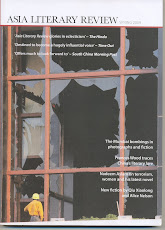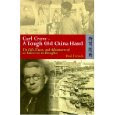Thursday, May 28, 2009
We have moved: Please visit chinarhyming.com!
If you follow China Rhyming via RSS, our new feed is here.
See you at the new site.
Wednesday, May 13, 2009
Deviation Posting: Time for a Good Left-Wing Read

The other day I had a meeting here in Shanghai with a visiting private equity type from America. He was extremely young in a sort of faux-donnish style and extremely right wing which made the non-essential chit-chat rather gruesome. As we parted he gave me a gift – a copy of Ann Rand’s Atlas Shrugged. He assured me that this was helping him through the current hard economic times when he felt his basic values might be challenged by such outrageous hard line socialists as Obama. I was naturally graceful in acceptance though having read it many years ago knew how distasteful I personally found the book and its message. Ho, hum.
Anyway, that got me wondering what classics we should be digging out and then by complete accident (serendipity I guess you’d call it) I came across The Independent’s feature - Black and white and red all over: Left-wing reads.
I’ll assume their first choice – Mao’s Little Red Book – was a joke
Then we get:
2) Robert Tressell’s Ragged Trousered Philanthropists from 1910 which I agree is a timeless classic – it’s been 20 years since I read it so that might be a good one to re-read
3) Franz Fanon’s The Wretched of the Earth from 1961 – ashamed to say have never read
4) Emma Goldman’s Living my Life from 1931 – a great read and reminds us there’s historically been more choice in American politics than the risible differences between Bush and Obama
5) Simone de Beauvoir’s The Second Sex from 1949 – which I personally remember as a bit of a slog
6) Steinbeck’s The Grapes of Wrath from 1939 – which I’m sure reads today as well as the first time I read it as a teenager
7) Gramsci‘s Prison Notebooks from 1929-35 – which I confess to occasionally still dipping into to keep on track
8) Walter Greenwood’s Love on the Dole from 1932 - which remains a classic British novel though rarely read I fear these days
9) Nikolai Chernyshevsky’s What Is To Be Done? From 1862 – which I did read ages ago but none has remained in my mind sadly
10) Radclyffe Hall’s The Well of Loneliness from1928 – never read, sorry
11) Erich Maria Remarque’s All Quiet on the Western Front from 1928 – which dad made us all read as kids to learn to hate war – it worked!
12) Upton Sinclair’s The Jungle from 1906 – which, talking of my dad, is his favourite book and which made a huge impression on me as a kid
13) Zola’s Germinal from 1885 – but then anything from Zola including especially I think La Bete Humaine would do
14) Marx’s Capital from 1867 – still original and best
15) Engels’ The Condition of the Working Class in England from 1845 – which I re-read recently over a long weekend in Manchester and is still great (there’s also an apparently an excellent new biography of Engels out too)
16) Mary Wollstonecraft’s A Vindication of the Rights of Women from 1792 – of course
17) Sidney and Beatrice Webb’s A New Civilisation from 1935 – questionable this one – important at the time certainly; the social engineering and USSR admiration comes over a little trite now though
18) Orwell’s Homage to Catalonia from 1938 – which is of course (as is everything) great and Orwell a God but if it was my list…as a socialist classic Road to Wigan Pier or Down and Out in London and Paris would win out
19) CLR James’ The Black Jacobins from 1938 – a classic from a great man – a socialist who loved cricket – now that’s who should run the world!
20) Rosa Luxemburg’s The Junius Pamphlet from 1916 – fascinating but I’m over by teenage crush on Rosa these days
A very interesting list and only a few I’d add:
Jon Don Passos’ USA – which make a mark on me as a lad
Orwell’s Keep the Aspidistra Flying
Rudolf Rocker’s Anarchism and Anarcho-Syndicalism
Anything by Tony Negri
And probably a few others that’ll come back to me as soon as I’ve posted this!
Tuesday, May 12, 2009
Shanghai Race Club - 75th Anniversary

The one thing most people know about old
Anyway, Byron’s also organising Shanghai Race Club Champagne Brunch on Sunday the 17th May (like many modern day Shanghail anders the concept of the Champagne Brunch seems to have an especial appeal – can there by anywhere else where people obsess and get excited about such a thing as Shanghai – I fear not). A bit of promotion for the board game but also to celebrate the 75th Anniversary of the Shanghai Race Club (building and grandstand as seen left). It should be interesting as Peter Hibbard, author of The Bund and
anders the concept of the Champagne Brunch seems to have an especial appeal – can there by anywhere else where people obsess and get excited about such a thing as Shanghai – I fear not). A bit of promotion for the board game but also to celebrate the 75th Anniversary of the Shanghai Race Club (building and grandstand as seen left). It should be interesting as Peter Hibbard, author of The Bund and
Anyway – details of the brunch here – which is being held at Kathleen’s 5 which is on the roof of the old Race Club building (now the Shanghai Art Museum though those with longer memories will remember it as the library and only those with really old memories will now remember it as the Race Club!). Kathleen’s 5 is a rooftop place so you get a view over what was the Race Course, now the morass of People’s Square.
Monday, May 11, 2009
Nazis on the Huang Pu

Of course the series of articles are far from definitive on the subject and, to be fair, you wouldn’t expect that. A full book on the subject remains to be written. There’s also a piece on Dai (Tai) Li and the fascistic Blue Shirts in Shanghai, the major Nazi Party leaders in Shanghai, a tie in with the opening of the new Sino-German movie about John Rabe (who was a Nazi Party member) and (beware plug coming!) an excerpt from my imminently forthcoming book on foreign journalists in China about the Nazi and anti-Nazi press in Shanghai during the period.
Sunday, May 10, 2009
Old Cemeteries, Graveyards and Remains
Of course I’ve visited the vast cemeteries now on Shanghai’s fringes but the downtown cemeteries are all built on. Interestingly no one much, in what can be a very superstitious city, seems bothered by this and I have no idea whether the old graveyards were just churned up or remains taken away. Some of the city’s most notorious buildings sit above former graveyards – the Pearl Oriental Tower must, at least in part, be built over the old Pootung Point graveyard while the fascistic architectural horror that is the JW Marriot at the ridiculously named Tomorrow Square sits on land (according to my old map of Shanghai) that was also a graveyard. Much the same appears to be true of Beijing – I recently went looking for a graveyard noted in an old record but it was firmly gone under the concrete of the Second Ring Road. As far as I could ascertain there was no formal removal of remains to anywhere else.
A few other cemetery related observations noted recently:
I just
 read Philip Pan’s excellent Out of Mao’s Shadow: The Struggle for the Soul of a New China which has a fascinating chapter on a surviving graveyard full of people who died in the Cultural Revolution- that it survived was remarkable; that people were intrigued and cataloguing the dead there a fascinating example of how not everyone accepts that all in China should just forget the CR in the rush to the glory and wonder of total KFCification.
read Philip Pan’s excellent Out of Mao’s Shadow: The Struggle for the Soul of a New China which has a fascinating chapter on a surviving graveyard full of people who died in the Cultural Revolution- that it survived was remarkable; that people were intrigued and cataloguing the dead there a fascinating example of how not everyone accepts that all in China should just forget the CR in the rush to the glory and wonder of total KFCification.I also recently bumped into Dvir Bar-Gal (at an incredibly bad talk by someone on the history of Baghdadi Jews in Shanghai by the way, where the speaker would neither discuss opium, slum landlordism or anything that might have reflected badly on the likes of Sassoon, Hardoon etc – really a very bad example of history as celebrity PR) who has done so much to preserve the Jewish headstones of Shanghai when he can find them. His latest efforts are noted in an article on the JTA website. Dvir notes that, ‘The four cemeteries that once served this city’s (Shanghai’s) small but prosperous Jewish community disappeared in the late 1960s during China’s Cultural Revolution. The sites were paved over to build a factory, park, hotel and Muslim cemetery, their history forgotten.’
Saturday, May 9, 2009
The Gurkhas, Justice and a National Embarrassment

It’s hard to be anything but disgusted with the British government’s attitude to the Gurkha’s and the pension row. The history of the Gurkas as fighting men in the pay of
From the end o f the Indian Rebellion of 1857 until the start of the First World War the Gurkha Regiments saw active service in
f the Indian Rebellion of 1857 until the start of the First World War the Gurkha Regiments saw active service in
For the purposes of this blog it’s worth remembering that the Gurka’s also saw active service in China during the Boxer Rebellion in 1900 (Gurkhas in China are pictured left) and Tibet during Younghusband's bloody Expedition of 1905. I’m not going to argue whether or not any of the wars above were politically acceptable – the Gurkha’s were a key part of the military arm of the
There is a campaign currently running to support Gurkhas and pressure the  nasty little self-centred careerist when he was head of the National Union Students in my college days - a real horrible little greasy pole climber who obviously hasn't changed one jot) continues to prevaricate and pettifog.
nasty little self-centred careerist when he was head of the National Union Students in my college days - a real horrible little greasy pole climber who obviously hasn't changed one jot) continues to prevaricate and pettifog.
If you want to support the campaign for full Gurkha Justice – on their site you can sign the petition calling calling on the UK Government to act immediately to change the law to allow all retired Gurkhas the right to stay in the
Friday, May 8, 2009
Nanjing Massacre Films

Two films are doing the rounds at the moment concerned with the Nanjing Masscare of 1937 - Lu Chuan's City of Life and Death, from the point of view of the city's military defense, civilian refugees, and Japanese invaders, and John Rabe, a Sino-German production, looking at the Massacre through the experiences of the title character, a German businessman with Siemens and Nazi Party member in China who helped set up a refugee zone in the city.
I haven't
 had a chance to see either film - and may well never see either as I don't watch TV much and never go to the cinema. Still they're hard to ignore and should be interesting one way or another for the reaction to them in China. Danwei has a post on both films and some initial reactions which I'll just link to for now.
had a chance to see either film - and may well never see either as I don't watch TV much and never go to the cinema. Still they're hard to ignore and should be interesting one way or another for the reaction to them in China. Danwei has a post on both films and some initial reactions which I'll just link to for now.







